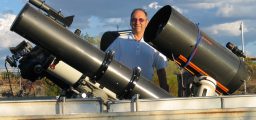Skyward for June 2021 By David Levy

Skyward for June 2021
By David Levy
Faint fuzzies.
The night before last, a comet named Palomar (actually known as C (for comet)/ 2020 T2 Palomar) was gliding near one of the most beautiful clusters of stars in the entire sky. It was parading about at about magnitude 11, which means that for my oldish eyes, it would be too faint to see. In fact, just a few weeks ago I spotted a second comet, named ATLAS. That comet, at ninth magnitude, was so diffuse that I barely spotted it. So I was not going to try for this other comet.
However, this other comet was named Palomar after one of my favorite observatories! The mighty 200-inch telescope was opened in 1948, just a couple of weeks before I was born, and the big telescope has been sighting stars for more than 70 years. In 1994, I was allowed to sit in the prime focus cage, that beautiful place where light from what the telescope is seeing comes to a perfect focus. So sighting a comet with that hallowed name would be special. The comet was discovered by Dmitry A. Duev on images taken using Palomar’s Oschin Schmidt telescope last October. As the comet was brightening slowly, I learned that on Friday evening, May 14, the comet was planning to glide past Messier 3, one of the brightest globular star clusters in the whole sky.
That was just too much to resist. Clusters of stars are scattered all over the sky, and our own galaxy has more than a hundred of them. Globular clusters consist of hundreds of thousands of stars. Messier 3 was discovered by Charles Messier, the famous Parisian discoverer of comets; it consists of some half a million stars and is more than 32,000 light years away. At about 11.4 billion years old, it is also one of the oldest things in the universe.
With the onset of darkness that Friday evening, I set up my telescope in my backyard observatory and pointed it toward Messier 3. The exquisite star cluster made its appearance. Then I nudged the telescope just a little bit to a nearby field of stars. Suddenly I spotted a faint fuzzy spot precisely where Comet Palomar was supposed to be. As I looked around, a meteor scratched the sky to the north. It was a bright and unusual member of the May Ophiuchid meteor shower, a bonus on this unforgettable night.
Comet Palomar is the 219th comet I have seen during my lifetime. Most of these comets have also been faint, barely visible spots of haze. But some have been wondrous. My first comet, Ikeya-Seki, was the great comet of 1965. Whether a comet is a faint fuzzy of a magnificent comet with a long tail, they are always welcome visitors to the Earth’s region of the solar system, each one signing, as comet finder Leslie Peltier loved to write, “its sweeping flourish in the guest book of the Sun.”
‐—————–
This is the dome for the 18-inch telescope, which Gene and Carolkyn Shoemaker and I used to discover tall of the Shoemaker-Levy comets, including the one that collided with jupiter in 1994. Photograph by David H. Levy.




Comments are closed.